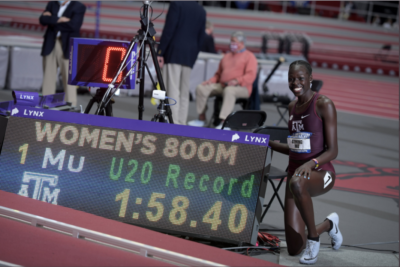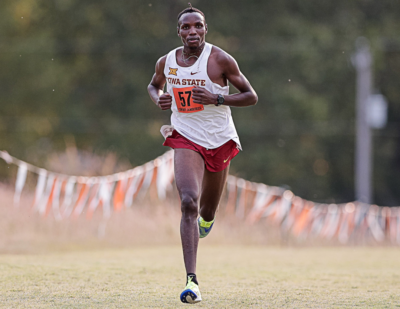2021 NCAA Indoor Preview: How Many Events Will Oregon Win, Which Stars Will Emerge, And More
By Jonathan Gault
March 10, 2021
Are you ready for March Madness?
(If you are and want to make it more interesting by playing in the $200,021 LRC Running Warehouse Prediction Contest click here)
No, not the basketball tournament. I’m talking about running, and the craziest weekend of NCAA action the sport has ever seen. Friday and Saturday, we’ve got the NCAA Indoor Championships in Fayetteville, Ark. And after waiting 16 months for an NCAA Championships, how long do we have to wait for the next one? One day. That’s right — the NCAA Cross Country Championships will be held on Monday in Stillwater, Okla.
The proximity of the two meets has, predictably, led to chaos. Some schools (NAU, Stanford) are going all-in on cross country. Some schools are going all-in on track (Oregon, Texas). And some schools (Arkansas, NC State), are trying to do both.
The madness doesn’t just stem from the cornucopia of action. This weekend is especially mad because we just don’t know quite what to expect. In track, we’ve seen fast times, but precious little championship racing over the past 21 months. And in this marathon cross country season (six months and counting), we’ve seen some big head-to-head matchups (BYU and NAU raced each other not once, but twice) but there was no Pre-Nats or Nuttycombe Invitational to sort everyone else out. With (almost) every team finally assembled at full strength in Stillwater, there are going to be surprises.
It’s going to be awesome.
With extremely limited in-person media allowed in Fayetteville and none in Stillwater, LetsRun.com will be covering this one remotely. But we’ll still be previewing and analyzing the races like usual and will have access to the virtual mixed zones to get insight from the coaches and athletes at each site. So without further ado, let’s get started by looking at the biggest storylines at the 2021 NCAA Indoor Championships.
*TV/streaming information *Schedule, entries, & results
1) Men’s race of the meet: the mile
A month ago, no collegian had ever run 3:50 in the mile or 3:34 for 1500. On Saturday, we should get a 3:50 miler (Oregon’s Cole Hocker) against a 3:34 1500 man (Washington’s Sam Tanner) in the mile final.
It’s not hyperbole to say that Hocker and Tanner are two of the biggest talents to come through the NCAA in recent years. In February, Hocker, 19, would have destroyed Edward Cheserek‘s NCAA mile record of 3:52.01 when he ran 3:50.55 had he not been beaten by teammate Cooper Teare (3:50.39 – Teare is running the DMR/3k at NCAAs). And after spending January dominating local races in New Zealand, Tanner, 20, exploded in his first race back in the US by running 3:34.72 at the New Balance Indoor Grand Prix on February 13 to take down the NCAA 1500 record of 3:35.01 — set outdoors by three-time NCAA champ Josh Kerr. Cheserek and Kerr were both NCAA legends. To see two guys — neither of whom is older than 20 — surpass them and then square off at NCAAs is a real treat.
Though Hocker’s seed time of 3:50.55 is significantly faster than Tanner’s 3:55.23 (Tanner’s 3:34.72 equates to a 3:52.26 mile per World Athletics’ scoring tables), Tanner deserves to be the favorite. His talent is evident, but he’s also proven himself to be a fantastic championship racer. In 2019, at the age of 18, he outkicked 3:36 man Hamish Carson to win the New Zealand 1500m title. And back in January, he closed in 54.2 (26.3 last 200) to win the NZ 3000 title over a field that included 2019 NCAA mile champ Geordie Beamish.
Hocker is no slouch himself, but there are more questions about him. For one, is he even a miler? 3:50 is exceptional, but he’s also run 7:46 for 3000 and was a Foot Locker champion in high school. For another, how will he handle a championship race? He’s run a solid 1:48.44 for 800 this indoor season but, through no fault of his own, he’s unproven in a championship final like this. And finally, will he be doubling back from the DMR? The guess here is no: Hocker is already entered in the mile and 3k on Saturday, and he wouldn’t anchor the DMR anyway (Teare will get that honor). So Oregon may well save Hocker’s legs and have someone else run the 1200 leg on Friday.
Hocker winning wouldn’t be an “upset” in the traditional sense, given he’s the top seed by five seconds. But taking down a total stud like Tanner would raise the ceiling on Hocker’s already gaudy potential.
There are a couple other guys worth watching in this race. First, Lucas Bons, the BYU freshman who shockingly hung with Tanner by running 3:55.45 at the Husky Invitational on February 27. A 4:09 high school miler, Bons is less than a year removed from a Mormon mission to the Ivory Coast where he contracted malaria “at least once, maybe a couple times,” according to his coach Ed Eyestone. How crazy was it for Bons to go from 4:09 to 3:55 in one race?
“In 21 years of coaching, it’s the most shocked I’d been at the end of a race,” Eyestone told LetsRun.
There’s also Alabama’s Eliud Kipsang, who split 3:51 on the anchor of the Crimson Tide’s DMR at SECs. And if you’re looking for a dark horse, how about Texas’s Yusuf Bizimana? A 1:46 800 guy from Great Britain, Bizimana beat 3:56 miler Takieddine Hedeilli to win the Big 12 title and came within .01 of winning the 800 at the same meet.
2) Women’s race of the meet: the 400
I’m giving props to superstar Texas A&M freshman Athing Mu for running the 400 at NCAAs and single-handedly making two events more interesting. Had Mu run the 800, where she ran a collegiate record of 1:58.40 at SECs, she would have blown everyone away, and I wouldn’t have cared much about the 400. Now the 800 is wide-open (the top four seeds are clustered between 2:01.96 and 2:02.35) and the 400 is must-watch because Mu is in it.
Mu, with her 50.52 season’s best, is the clear favorite in the 400, though the #2 seed is pretty interesting too. Like Mu, Talitha Diggs (51.14 sb) of Florida is only a freshman. And she has strong bloodlines: her mother is Joetta Clark Diggs, a four-time Olympian with a 1:57 pb at 800. But mostly I’m interested in seeing how fast Mu can run. The collegiate and American indoor record is 50.34, set by USC’s Kendall Ellis at NCAAs in 2018. That would take an exceptional run, but it’s certainly within Mu’s capabilty. Anything beyond that is a bonus, but in case things get really crazy, I’ll just let you know that the world indoor record is 49.59 by Jarmila Kratochvilova (not happening) and that only three women have ever broken 50 indoors (slight chance).
3) How many events can the Oregon men win?
With NCAA Indoors and NCAA XC back-to-back, top programs had to choose how best to deploy their resources. Mostly, they have chosen to pursue the championship they have the best shot at winning. Distance schools like NAU and BYU went all-in on cross country. Oregon, with Teare and Hocker, would have been competitive in cross country, but lacked the depth to win it all. In track, meanwhile, the Ducks are the red-hot favorites. Not only do they get Teare and Hocker — who get to face weakened fields with the likes of Notre Dame’s Yared Nuguse and NAU’s Luis Grijalva opting for XC only — but they add in Charlie Hunter (#1 seed in the 800), Micah Williams (#1 seed in the 60), and six other individual qualifiers.
Oregon should romp to its first men’s title since 2016. The more interesting question is how this Ducks squad can stack up to some of the great distance squads of years past. Oregon has the top seed in the 800, mile (Hocker), 3k (Teare), and DMR (the Ducks ran 9:19.42 on January 29 to take over five seconds off the collegiate record). Only eight teams have won three or more men’s distance events at the same NCAA Championships.
Men’s teams to win 3+ distance events at NCAA Indoors
| Year | School | Winner #1 | Winner #2 | Winner #3 |
| 1979 | UTEP | Suleiman Nyambui (mile) | Suleiman Nyambui (2-mile) | Michael Musyoki (3-mile) |
| 1981 | UTEP | Peter Lemashon (1k) | Suleiman Nyambui (2-mile) | Michael Musyoki (3-mile) |
| 1982 | UTEP | Suleiman Nyambui (mile) | Suleiman Nyambui (2-mile) | Gabriel Kamau (3-mile) |
| 1994 | Arkansas | Niall Bruton (mile) | Jason Bunston (5k) | DMR |
| 2003 | Arkansas | Chris Mulvaney (mile) | Alistair Cragg (3k) | Alistair Cragg (3k) |
| 2009 | Oregon | Galen Rupp (3k) | Galen Rupp (5k) | DMR |
| 2015 | Oregon | Edward Cheserek (mile) | Eric Jenkins (3k/5k) | DMR |
| 2016 | Oregon | Edward Cheserek (3k) | Edward Cheserek (5k) | DMR |
Look closely, and you’ll notice one of those teams won four NCAA titles: Oregon in 2015. That squad is the gold standard when it comes to dominance, racking up 70 points in the distances alone. For comparison, only one other entire team — Arkansas in 2013 — has scored 70 in the last 27 years.
If I were running a book on NCAA Indoors (for the record, I’m not), I’d set the over/under on Oregon distance titles at 2.5. The Ducks should win the DMR (no team has run within eight seconds of them this year) and between Teare and Hocker, they have the top two seeds in the 3k and should win that too. In the 800, Hunter has been on fire this year, but he’s seeded just .09 ahead of Texas Tech’s Takieddine Hedeilli, a fine athlete in his own right. And, as mentioned above, Hocker is far from a lock to win the mile. I’d be surprised if Oregon won less than two distance events, but I’d also be surprised if they won more than three.
4) Which stars will emerge this weekend?
The NCAA is the greatest talent development system in the world and it is constantly replenishing the talent base. New stars are minted every year, but we can’t always identify them immediately like Athing Mu. Take Bryce Hoppel. In 2019, Hoppel was a junior at Kansas who entered the NCAA Indoor Championships as one of the country’s top 800 runners, but nowhere close to a household name. His win there served as a launching pad for a season that culminated with Hoppel finishing 4th at the World Championships in Doha.
That is the beauty of the NCAA Championships: throw together the top 16 collegiate athletes in each event, each of whom have spent months preparing to be at their best for this meet, and you are going to end up with some stellar performances and a few burgeoning superstars.
Who will that be in 2021? Well part of what makes the meet intriguing is we don’t quite know yet. But here are a few athletes to watch:
- Courtney Wayment, BYU (3k/DMR): Last year, BYU’s Whittni Orton was poised to become the breakout star of NCAA Indoors as the top seed in the 3k and the anchor of BYU’s top-seeded DMR but never got the opportunity to compete when the meet was cancelled 24 hours out. Orton is out of indoor eligibility (she’s running NCAA XC on Monday though) but has essentially been replaced by her teammate Wayment, who ran the fastest times in the NCAA in the mile (4:30.47) and 3k (8:54.90) this year and will attempt the same 3k/DMR double.
- Sage Hurta, Colorado (mile): When Hurta lined up for the 800 at the Razorback Invitational on January 30, it marked her first track race for Colorado since May 2018 — she redshirted in 2019 and didn’t race at all in 2020. So in case you forgot, here’s your reminder: Hurta is a stud. In 2019, she ran 2:00.99 and 4:09.37 outdoors, and I have to imagine she has improved in the almost two years since then. She just hasn’t had a chance to show it yet. Until now.
- Mario Garcia Romo, Ole Miss (3k/DMR): The 21-year-old Spaniard posted one of the most impressive races of conference weekend by closing in 53.14 (25.39 last lap) to win the SEC 3k over studs Eliud Kipsang and Amon Kemboi. Teare and Hocker have the gaudy times, but Romo has a killer kick. If he’s there with a lap to go, watch out…
- Micah Williams, Oregon (60): Williams is one of those athletes who may have been a bigger name had his senior year of HS not been wiped out by COVID. In 2019, he ran 6.60 to break the high school junior class record and came .03 off the national record. That spring, he ran 10.21 for 100m as a 17-year-old. This year, as a freshman at Oregon, he’s won all six of his races, including a 6.49 at Air Force on February 27 that was the fastest time for a collegian since Christian Coleman in 2017. Williams is young, and he’s very, very good. He may be one and done so catch him while you can.
- KC Lightfoot, Baylor (pole vault): Okay, this doesn’t really count as a star emerging, considering Lightfoot has already broken the collegiate pole vault record three times this year, including the first-ever 6.00m clearance by a collegian on February 13. Still, clearing 6.00m on the big stage of the NCAA meet could boost the Baylor junior’s popularity.
- The entire men’s 400 field: Last year, NCAA men’s 400 runner ran faster than 45.51. This year, seven men have accomplished the feat, led by Ohio State’s Tyler Johnson (45.07). It’s gonna take something fast to win this race. Only 9 men in history have ever broken 45.00 indoors.
5) Quick predictions for all 10 distance events
Between NCAA Indoors and NCAA XC, we simply don’t have time to write a detailed preview of every distance event. But I’ve still gotta write something. So let’s take a quick trip through each event and make some picks…
Men’s 800: Oregon’s Charlie Hunter and Texas Tech’s Takieddine Hedeilli are almost a second-and-a-half faster than anyone else this season. Both men could also feature on their DMRs, but I like Hunter to bounce back stronger and win the 800 — his pb of 1:45.59 came less than 24 hours after running a mile pb of 3:53.49.
Men’s mile: I previewed this race earlier. Sam Tanner FTW.
Men’s 3000: Oregon’s Cooper Teare and Cole Hocker have been exceptional this year in time trials. NCAAs will be a different sort of test. Or will it? At the Razorback Invitational on January 30, Teare and Hocker ran the two fastest times in the NCAA this year thanks to Teare’s determined front-running. That helped them burn off big kicker Mario Garcia Romo of Ole Miss, who wound up fourth in that race. (I don’t expect Hocker, doubling back from the mile final just an hour earlier, to be a factor here.) Will Teare be bold enough to try to win again from the front? Or will he allow things to go slow and trust his closing speed (he is a 3:50 miler, after all) against the big kicker Romo? I’m going Teare FTW after he makes a big move with around 1k to go.
Men’s 5000: Iowa State’s Wesley Kiptoo has been close to unbeatable this year — Teare and Hocker have been the only guys to beat him since he enrolled at Iowa State in the fall. With neither of those guys in the field, I expect this race to go just like one of his cross country victories, with Kiptoo — who is doubling back for NCAA XC on Monday — setting a hard pace early and breaking the entire field. Kiptoo FTW. He’ll then try to become a legend and win NCAA xc a few days later against guys who sat this one out.
DMR: Oregon broke the collegiate record by 5+ seconds and has a 1:45 guy, a 1:47 guy, a 3:50 guy, and a 3:56 guy available for the first three legs, all waiting to hand off to a fresh 3:50 guy (Cooper Teare) on anchor. I’m hardly going out on a limb by predicting the Ducks to win their fifth DMR title in the last 13 years.
Women’s 800: With no Athing Mu, this could come down to a rematch of the ACC final, where Virginia Tech’s Lindsey Butler edged Clemson’s Laurie Barton, 2:01.96 to 2:01.99. I’ll take Butler, again.
Women’s mile: Sage Hurta is the next big Colorado star. She’ll show why when she wins this race.
Women’s 3000: When you’re the NCAA leader in the mile and 3k, it’s hard to pick against you. Courtney Wayment FTW.
Women’s 5000: Arkansas’ Katie Izzo is the NCAA leader by over six seconds, but she lost twice at SECs to Auburn’s Joyce Kimeli. Kimeli is my pick for the win.
Women’s DMR: Arkansas is the NCAA leader at 10:53.77, but their coach Lance Harter told me he’ll be using Lauren Gregory on anchor rather than their top miler, Krissy Gear. Gregory is no slouch — she has run 4:32 — but it worries me that she was only 3rd in the SEC mile. I feel better about BYU and their anchor, Courtney Wayment, but their seed time of 11:03.62 is almost 10 seconds slower. Will she get the baton close enough to the lead? I’ll gamble and say yes. BYU FTW.
***
Looking back at my picks, I realize I’ve picked the #1 seed in seven of the 10 events, which means I’ve definitely screwed up. There is simply no way in a season this unpredictable that we get that much chalk at NCAAs.
Oh well. Enjoy the madness!
6) Team battle
To get an idea of what to expect in the team battle, my colleague Robert Johnson scored the list of entrants by going straight down the descending order list. He did it for the top 5 ranked men’s and women’s teams. Here are the results.
Top 5 Ranked Women’s Teams Projected Scores at NCAAs Based on Entries (national ranking on left)
#1 Arkansas – 58
#2 Texas A&M – 58
#3 Texas – 47
#4 Georgia – 37
#5 Florida – 32
That’s pretty amazing. At the SEC meet, Arkansas won with 141 and Texas A&M was just 8th with only 38 points. Now, at SECs A&M didn’t run their #1 seeded 4 x 400 team and their star Tyra Gittens, the #1 seed nationally in the pentathlon was only 6th in the pentathlon (she won the LJ and HJ). If A&M is able to upset Arkansas on Arkansas’ home turf, Gittens will have to have a monumental meet. She’s the #1 seed in the multi and HJ and the #5 seed in the LJ.
For the men, the stats predict an Oregon runaway as expected.
Top 5 Ranked Men’s Teams Projected Scores at NCAAs Based on Entries (national ranking on left)
#1 Oregon – 72
#2 LSU – 49
#4 FSU – 33
#3 Arkansas – 28
#5 Florida – 28
Play in the $200,021 LRC Running Warehouse NCAA Prediction Contest here





